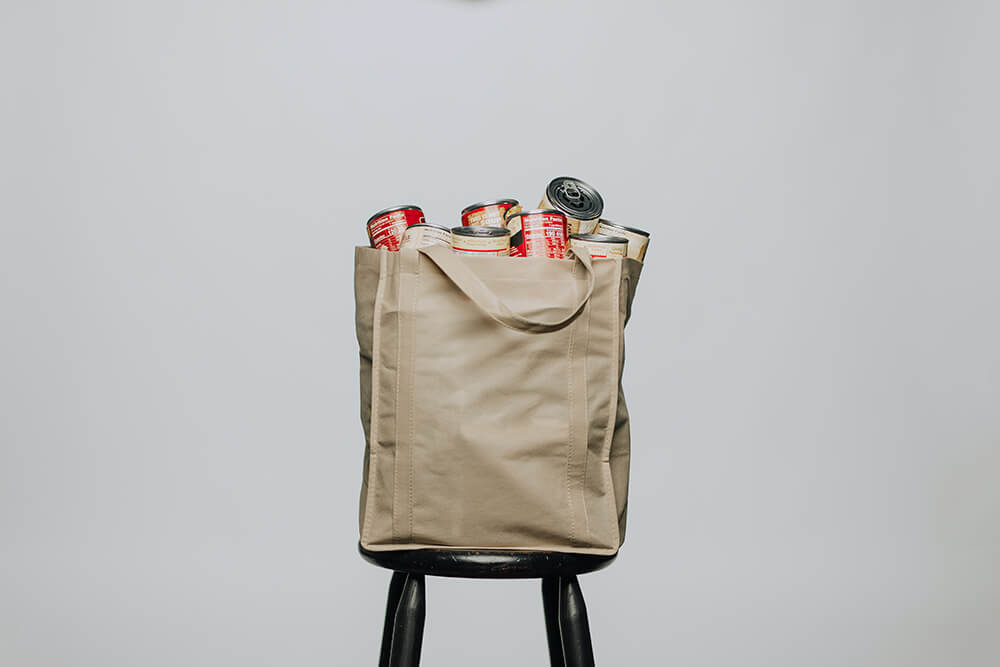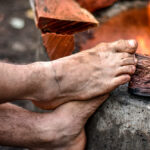A camping buddy of mine, Dave, recently came back from a trip to British Columbia. His crew ran into a bit of a snowstorm. Luckily for them, they came across a log cabin that erected near Bear Lake, for such situations.
The cabin was full of expired food, which the crew ended up leaving alone. Dave and company were prepared with food supplies, and they didn’t want to risk eating food that could have expired years ago and get food poisoning. Dave then posed a question to me that got me thinking. He asked if I were in position ‘what would I have on my list of the longest-lasting food for survival’?
Just my opinion and experience with food rationing dates back to when I was aged seven. My Grandfather tasked us grandkids to fill his Camper with his coveted tins of food and vacuum-sealed dried beans. This is when we started affectionately calling him the can man.
After careful research we devised a list of staple food supplies that can be brought in a campervan, backpack or thru-hike scenario. Aside from the twinkies, the aim was to catalog foods that are healthy, convenient, have a long shelf life and food that lasts 25 years.
Why do foods have different shelf-lives?
Exposure is the main factor that determines the speed at which food degrades. Exposure to temperature, oxygen, moisture, and contamination will cause food to spoil.
Internal factors such as items mineral, nutrient, pH, and water content will contribute to shelf life.
The balancing act between weight, dimensions, taste, and longevity.
Its always good practice to plan your food rations with the setting, timing, and team in mind.
Firstly, take into account who will need to eat, how long will you be away for, how much space you have for food and what conditions are expected on the trip.
Determining how much food to bring on a camping or hiking trip, you want to find out your equipment carrying capacity.
To do this firstly, you should take count of your essential gear and equipment — essential items such as clothing, hygiene and first aid items.
Any room left over after subtracting your essentials should be allocated towards food and water.
For example, if you are only using a backpack on your trip firstly determining what you need to bring, clothing, layers, toiletries, survival gear, etc.
Then any room left over in your bag can then be allocated to food and water rations. A campervan will have a pantry allocated for food storage, and a vehicle will allow for even more food inventory.

Time and temperature will be the most notable factors in how long stored food will survive and remain palatable just my opinion.
However, there’s no filling up your backpack with heavy canned if your only planning on a two-day camping trip.
The same theory applies to the dimensions of your food. While a loaf of bread may be a nice reward after a long hike, it does take up a lot of space. Consider easily packable low GI high carb trail bars instead.
Pay attention to weight as well; you are going away with a campervan than food weight will have little to no impact on slowing you down.
But if you are backpacking than cans of food not only slow your pace but may cause back issues.
Opting to mingle in low density and heavier packaged foods will be ideal like cans of baked beans and tuna, with pouches of nuts and grains.
Taste and longevity of foods
NASA has drawn similarities in the food planning process for camping and trips and rationing astronaut food for a space trip emphasizing the importance of avoiding food spoilage.
The space agency has also emphasized that space food is as important as how long the food can last on a mission. There is no real point in providing an inventory of food that the astronauts are not going to like eating.
The goal of long-lasting foods is that they retain a palatable taste for as long as possible. Thereby selecting foods that are tasty and last longing is a small yet invariable pleasure for astronauts already dealing with the stresses of being in outer space.
When packing rations for camping, you want to follow the same principles. Prepare foods that are long-lasting, nutrient-dense, tasty that have a healthy Marco base, good fats, proteins, and carbohydrates.
Long-Lasting Foods for Surviving Worst-Case Scenarios
Revisiting Dave’s first scenario. Let’s say you have stumbled across a log cabin full of food in the nick of time and during a catastrophic event. What foods would be safe and long-lasting that would get you and your comrades through this dangerous situation while avoiding food poisoning?
Below is our list of foods that meet the criteria of longevity, durability, palatable and macronutrient dense. The designed list below takes into account the weight and dimensions of each ration. Each item will be packable and comfortable in your backpack, campervan, vehicle or horseback if you so choose.
Is there food that lasts 25 years?
Honey (100-1000 years)
So there is not determined expiration date with honey. This golden liquid made with honey bee love has been found preserved in the tombs of Egyptian Pharaohs unspoiled have thousands of years.
Honey will go through a physicality change as the year’s progresses. Initially, it will start to look cloudy; then after years of food storage, it may begin to look grainy. The discolouration will occur after five or so years with the honey forming crystals a decades later.
Getting it back to its original composition is a simple process of heating it for 15 minutes at a temperature of 50-degrees celsius. Honey has a high acidic value and can be used as a layering agent to slow down the aging process of other fresh foods.
Stock/bouillon (10+years)
Chicken or Beef stock cubes while not essential for survival can be added to soups and even water to enhance the flavour of comfort food.
Because Bouillon and Stock cubes are removed almost entirely of moisture, they are incredibly long-lasting up to 10 years. Increasing Its shelf life but can be done through the use of vacuum packing and resealable bags with moisture absorbers.
The small dimensions of the stock cubes will mean that you can find a bag full easily in your backpack without being noticeable.
Salt (100-1000 years)
One of the main rivals to honey for the longest-lasting food ingredient title is Salt. Salt is a mineral that is universally regarded as a necessary evolutionary taste and is essential for all lifeforms.
Salt not only assists in the maintenance of electrolyte balance and nerve impulses, but sodium ions drive metabolic and heart functions of mammals.
The use of salt dates as far back as 6000 BC and historically has been used to preserve and cure foods for the journey along long and arduous trade routes.
Eliminating moisture and salt exposure can allow for an infinite shelf life. On its own, Salt isn’t usually considered a satisfying meal alternative.
But adding a few spoonfuls in your water to help aid the promotion of electrolytes and give bland food some added flavour.
Sugar (18 months to 30 years)
Sugar is similar to Salt in its ability to stay fresh and usable after a long time. However, due to the chemical makeup and stickiness of sugar as compared to Salt, sugar will tend to harden into a solid-state over time.
Storing sugar in vacuum-sealed containers or an airtight jar will extend its shelf life, and these factors are the reasoning to its wide self-life range.
Sugar is found in the tissues and stems of plants, think of sugar can and even maple trees. However, there is no survivalist reasoning to take sugar with you on a camping trip if only to give your coffee an extra kick before a long hike out.
Oils and ingredients that last for years
Apple cider vinegar (5 years)
Apple Cider Vinegar has been featured prominently in health magazines and youtube videos promoting its benefits for fat loss and from boosting metabolism and lowering insulin and blood sugar levels to adding a bit as an ingredient to a salad dressing.
For all the above reasons, it may be an excellent addition to your survival inventory. On the plus side, due to its high acidity, ACD won’t require refrigeration.
You can expect at least five years of freshness until the vinegar expires and that’s even after it’s been opened.
Check the expiry date and look for discolouration or excessive sludge on the inside base of the bottle as indicators its no longer consumable.
Soy sauce (3 years)
Dating as far back as 2000 BC, the simple condiment made up of soybean paste and brine has been known to last up to five years opened and unrefrigerated due to its high sodium content.
The sauce does tend to absorb certain aromas of its surrounding environment and certain fumes. In all honesty, there should be no logical reason to pack that odd-shaped glass bottle of soy sauce on a camping trip.
A teaspoon of Salt with water should satisfy the acquired salty taste if under duress.
Flour (2 years)
Seeds, grains, cereals, maize, barley, millet, brown rice, and roots can be all be ground and powdered into flour.
Flour can be a crucial ingredient when making a damper bread over a campfire. Just add flour, oil, Salt, and water and you have yourself a moreish and filling bread. The primary ingredients before they are ground can last up to 20 years, but grinding them into flour can significantly reduce its shelf life.
Similar to Salt and sugar, you want to keep your flour moisture-free, vacuum-sealed which maxes out the long to 12-24 months.
The flour will start to smell and if not stored correctly may attract insects that use the ingredient to lay eggs, so make sure you view and smell aged flour before use.
Ghee (2 years)
There is a lot of conflicting information on the short and long shelf life of Ghee with the majority of survivalist forums opting not to settle on a specific timeframe.
The indifference on the accuracy of a shelf life seems to come from how Ghee is made. Ghee is its initial form is butter that has been simmered and clarified and its impurities skimmed and the process repeated until all moisture has evaporated.
Ghee aged up to 100 years is a delicacy and will demand a high price point. Ghee is still a milk product and to be on the safe side, two years seems to be the most widely agreed shelf life amongst high brow adventurists.
Coconut oil (10 years)
While the first oil most would think of to pack is Olive Oil. Coconut Oil has a greater expiry period and more uses than just aiding in cooking game and fish on a campfire.
Coconut oil can hold a solid shape at normal room temperature, yet it can melt at body temperature. This talented substance can be used as a hand cream, a lubricant for tools or a hair conditioner.
Coconut oil, when stored properly, can last up to 10 years due to its antibacterial and antifungal properties. In my opinion, the smell of coconut is very appealing.
It’s worth mentioning that Olive Oil, in comparison, only has a shelf life of two years, will start to smell stale and unusable shortly after.
Powdered milk (20 years)
Baby formula, protein powdered, creamer or plain powdered Milk, if stored properly without contamination from moisture and oxygen can last up to 20 years.
High in protein and a complimentary supplement for tea and instant coffee. Powdered milk products are easily packable and can also be modified with additional ingredients to create bread, cheeses, and yoghurt.
Opt to store powdered Milk in tins or glass as it will tend to the chemical taste of plastic.
Fruits and vegetables; canned and dried (2-10 years)
Canned or dehydrated fruits and vegetables are, for the most part pretty accessible; you only need to go to the local supermarket to see a whole aisle dedicated to them.
Packed as you would have expected, vitamins, minerals, antioxidants, carbs, and fibre fruit and the vegetable area must pay for camping and long hikes.
Canned fruits and fresh vegetables goods are foods that last up to 2-5 years, but its shelf life will decrease to only one week once opened, and this is refrigerated.
Dry and dehydrated fruits and vegetables (think of banana chips) can expect the longest shelf life of up to 10 years. Here the food has been processed to remove all moisture content and stored in an adequately sealed container you.
Freeze-dried fruit and fresh vegetables can be expected to last up to 20 years. However, they require optimal conditions such as a cold underground bunker without damage to its vacuum-packed containers.
Dried herbs & spices (2 years)
Excluding Salt, other dried spices, herbs and seasoning great for enhancing bland canned foods and soups are foods that last approximately two years.
While not essential in a survival situation if you are going to bring a ration of spices to make sure you store them in an airtight and watertight container.
Spice food stored will lose their flavour and pungency when left exposed. If you have the time and energy to forage than particular wild plants can supplement and simulate a familiar taste.
Baking Soda (18 months)
While it’s not considered an edible food, baking soda is a great addition to your camping inventory.
While it is used in some cooking recipes, baking soda is a great cleaning ingredient and can be used to neutralise odours and de-grease cookware and utensils.
While some may think this ingredient would have long term food storage and an indefinite shelf life it only has a short shelf life on only 18 months.
Beans & legumes; black, garbanzo, kidney, lima, mung, pinto, adzuki dried beans, peas and lentils (5-30 years)
Consider the Bean family the Allstars of long-lasting foods that should be taken on a camping trip or hike to take with you in case of emergency.
For this scenario, we have decided to include canned beans and dried beans. Either way, beans are high in protein, vitamins, and minerals, have a long expiration period of 5-30 years depending on the food storage method.
Beans are also high in fibre and carbohydrates. Being high in calories means that if you do find yourself in an extreme situation where food is scarce, then the added calories will satiate the body and provide lifesaving energy.
Make sure to add moisture absorbers in with the dried beans and keep them sealed from moisture and oxygen as exposure to the elements will harden them.
Making the beans harder to digest and extending the time you will need to cook them so soften them up.
Meats; Salted, Cured and Canned (2-5 years)
High in protein and calories. Canned meat, whether it be corned beef, sausages, SPAM, chicken, canned fish or seafood, will become the most amazing tasting substance you will ever experience.
After being lost in the wilderness with a mild case of hunger. Canned food stored in your backpack but will be convenient for any campervan pantry. If you do choose to bring a few cans of canned fish in your hiking pack, opt for stout and stocky cans that fit on top of each other.
You can use a small case to neatly stack and efficiently manage the real estate within your backpack. Longest shelf life life varies amongst canned meat goods. Typically most emergency food experts suggest the life expectancy of about 2-5 years for canned meats; however, this is dependant on the leanness of the meat.
Canned meat that is high in fat like beef will perish faster than lean meat. This is due to oxidative rancidity. A common occurrence with fats absorbing undesirable flavours and odours.
With canned fish, make sure to read the expiry label, if there is no label check for damage, rust, bulging or discolouration of the can before digging in.
Salting meat for preservation
Salt has been used for thousands of years to cure seafood and meat, extending the shelf life for up to two years. The process of using pure crystalized Salt or brine made up with a minimum of 20% salt concentration in combination with a drying method is a minimum required to kill bacteria and to allow the meat for consumption.
Today cured meats are considered a delicacy as modern-day freeze-drying can extend the shelf life of chicken and beef to more than 20 years.
Freeze-drying, for the most part, cannot be done with essential equipment and requires the combination of vacuum sealing and liquid nitrogen to complete the operation. Once the seal is opened, the meat will exponentially perish within 12 months.
Long lasting, high in protein pemmican
Pemmican is a product of Native Americans which combines wild berries, powdered or lean dried meat and animal fats.
High in calories and protein, this survival food history made from game meat has an astonishingly long shelf life of over 20 years. This is due to the drying process of the meat in addition to the rendering of the animal fat.
Overextended periods and heat, when mixed with the berries, produce a malleable product that can be shaped to your desire.
Alcohol; wine, hard liquor, spirits (10 years)
Alcohol is probably the last thing any experienced hiker, climber, camper would think of taking. It offers little nutritional value and could even be the cause of a crisis.
Additionally, unless you flask the alcohol or wine, it can be quite cumbersome to store and pack. It is worth noting that hard liquor and wine do have extraordinary long-lasting self lives if kept unopened and in a cool place like a deserted log cabin in winter.
Alcohol and wines will change in shelf life and taste while open, so if you do have to drink it, make sure it’s within a week to a few months.
Who knows it may help pass the time in a survival situation if you find yourself snow or caught in a sandstorm.
Powdered hydration; tea, coffee, electrolytes (2-10 years)
Sachets of coffee, tea, cocoa and energy drinks in the optimal conditions will have a shelf-life of up to 10 years. These convenient pouches of powdered substances, when mixed with cold or hot filtered water.
Will provide the hydration and energy you require to get through some vigorous draining activities such as a long thru-hike. However, if the Sachets or seal becomes compromised and left exposed to oxygen for one of these powdered drinks, it will typically become hard and lose flavour.
But can easily be resurrected by grinding the product in a pestle and mortar.
Meals ready to eat (MRE’s) (10-30 years)
MRE’s are manufactured with one in mind, to provide ready durable emergency food that last a long time during a survival or emergency.
Think of a healthy frozen microwavable meal that does not need freezing and in most cases be eaten with no other ingredients required straight out of the packet ready for immediate consumption. MRE’s are packed with a solid macronutrient profile.
Every meal will hit the necessary fats, carbohydrates, protein and vitamin requirements that can fuel mission-ready military elite. Due to the stringent packaging and sealing methods, MRE” s will have a shelf-life of up to 30 years.
What’s even better is that the packable packaging is also a piece of technology that serves to be durable to withstand a range of temperates and most times, hole proof. MRE’s are readily available in most adventure and survival stores.
And contain flavours such as sausage and mash, pasta, and meatballs or beef brisket and fries quite appealing.
Twinkies (30 years)
You’ve come across a deserted cabin, you and your comrades had a heated battle royale game of rock paper scissors for who gets to eat the prized twinkie.
Yes, twinkies that are high in fats and sugar and offer little in terms of nutritional value can make that time in an emergency feel slightly better.
There is a great skit on the Simpsons about the formidable long-lasting twinkie at the Kwiki Mart.
This theory has even been testing by a Science teacher who at a 30-year-old twinkie in 2012. He survived to tell the tale, of course, noting that the twinkie was a little stale.







